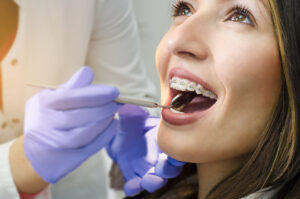Clear aligners have changed the game for individuals whose teeth need to be straightened. Now there’s an option beyond metal braces for getting a great smile. But how do you decide which orthodontic s treatment is best for you? This article will discuss some of the pros and cons of each, as well as addressing situations that merit one over the other.
The Benefits of Clear Aligners
Clear aligners enable patients to go through a course of treatment without drawing attention to the equipment used in that treatment. From an appearance standpoint, clear aligners are practically invisible. In addition to providing a more natural-looking smile during treatment, the trays can be removed for cleaning, eating, and high-contact sporting events. That means patients don’t have to avoid hard or sticky foods during treatment. They can remove the tray and eliminate the risk of damaging the appliance while eating. Many adults choose clear aligners because they don’t want to be perceived as juvenile simply because they sought orthodontics treatment later in life.
The Benefits of Braces
Braces have long been the tried-and-true method of teeth alignment. Because braces don’t have to be custom designed, they are often the less expensive of the two options. Furthermore, braces do more than straightening teeth. They are the instruments of correcting a patient’s bite, too. The wire memory methodology employed by braces enables the orthodontist to move individual teeth in three different directions. Unlike clear aligners that only tip and torque (move forward/backward or lean side to side), braces also slide teeth horizontally. As a result, braces are the preferred treatment option for the most challenging orthodontics cases.
The Downsides of Clear Aligners
While clear aligners are subtle, easy to remove, and custom-level comfortable, they are not without their downsides. As mentioned in the previous section, they cannot handle any orthodontics treatment that would involve sliding the teeth horizontally. Therefore, they’re not great options for individuals with severe overbites or malocclusions. Moreover, because they are removable, it makes it tempting for patients to not wear the aligners as many hours as they should, prolonging the treatment process. Also, there are a number of DIY aligner kits that omit the professional discretion of a licensed orthodontist during treatment. Finally, aligners tend to be more expensive, putting them out of reach for some patients.
The Downside of Braces
The metal brackets and wires of braces can be uncomfortable, especially at the beginning of treatment as the patient adjusts to having them on. They can be tricky to keep clean, and patients should avoid hard and sticky foods to prevent damaging the wires and brackets. Finally, braces are more visible than clear aligners.
When Might Orthodontists Recommend Each?
Despite the various pros and cons, there are times when an orthodontist might recommend one over the other. In the case of braces, orthodontists are likely to recommend them for the more severe cases, specifically those in which the bite needs to be adjusted. Aligners might be the recommended treatment for an adult in a profession that requires them to maintain a certain appearance.
Regardless of whether you choose braces or aligners, it’s important to have a licensed orthodontist be part of the process in order to achieve the best, longest-lasting results.









